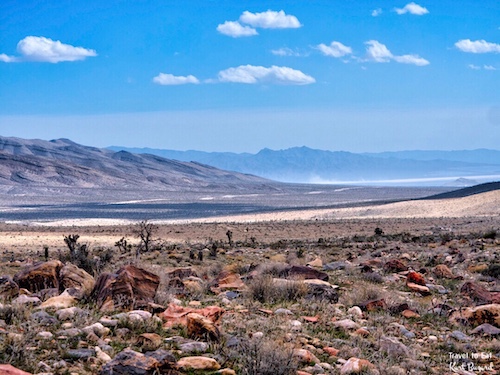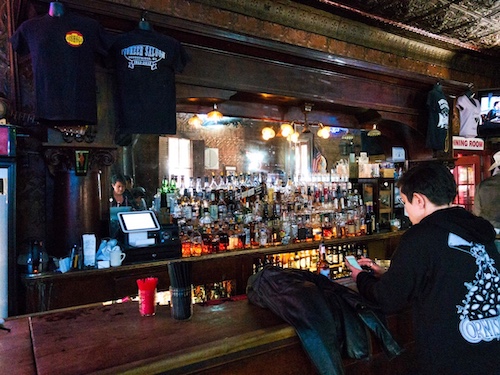
Literally hundreds of petroglyph sites exist in Southern Nevada, and many are only known by expert archaeologists out of concern of thieves. However, because petroglyphs are carved into enormous rock formations, it is extremely difficult to pilfer them. Some petroglyphs are located in dangerous places, like cliff edges, and near boulders. While we cannot really decipher their meaning, many people most notably LaVaun Martineau, have made significant progress in deciphering their meaning. Martineau actually lived with the Paiute Indians and used his experience with cryptography obtained during WWII as a starting point for his analysis. This post is focused on a set of petroglyphs near Goodsprings Nevada.
Time Petroglyphs





The meaning of petroglyphs is always tricky but the rake or comb symbol at the top is usually a measure of time. The comb symbol can also indicate general upward or downward movement. The bottom symbol indicates that the travelers came from a long ways away. The downward steps may represent a canyon with a village at it’s base (eyes represent a people). Alternatively the wavy line could represent the Colorado river. The bottom photo from the right side of the stone represents steps, another sign of distance, with a village on the way (eyes with a square).
Marker Petroglyphs


This is a marker stone, giving directions to the main petroglyphs. I really do not completely comprehend the directions but this seems to indicate three separate main depictions of which I found all three, the “time petroglyphs” (on the left), the marker petroglyphs (on the right) and the main one in the middle. The round mark with dots in the left of the photo is just the saying Paiute version of “you are here” but also indicates that the main panel is in a hollow.
Primary Petroglyphs



This is the main petroglyph at the site. As I noted above, it is located in a hollow between two rocks. You can see a number of symbols and I thought we would explore a few.
The Schematic Goat


This set of symbols is relatively straightforward to understand. The lines to the left represent the mountains just behind this petroglyph. The four legged animal does not actually represent an animal but is actually a schematic figure, you can call it a goat, antelope or whatever. In this circumstance the goat is walking away from the mountains and it is easier to draw a four-legged animal to indicate direction than using a human. The antlers on the animal are swept back. According to Levan Martineau, the antlers are an indication of sign language. To show a completed movement in sign language the hand is pushed out away from the body in a sweeping arc. When the arc which depicts movement is doubled as in the above petroglyph this indicates that that something has been either taken, wiped or knocked off or that there was nothing there to hinder the movement or journey. Thus the combination of the animal with two swept back horns and the wavy line following the animal all combines to describe an uneventful trip away from the mountains.
A Difficult Journey


We can contrast the first trip with the one below it on the petroglyphs as seen above. Here we see the four legged animal at the beginning of the trip with vertical horns indicating something bad happened, This is followed by an upside down man, perhaps holding his head in his hands indicating someone died. The following goat has curved back antlers, indicating an uneventful remainder of the journey but note the fact the animal is running, probably they hurried through the rest of the trip.
More Voyages


The bottom section of the petroglyph wall shows a series of voyages.
A Voyage to the Chief or Shaman

In this voyage they travel to visit a chief or shaman, possibly to try to heal members from the previous trip.
A Scouting Trip

The last set of petroglyphs detail a scouting voyage when the participants scouted the area, going through a valley, over a mountain and found a place of interest. These are my current thoughts on these petroglyphs from Goodsprings, I am still learning the “language of the rocks” but these insights should get you on the right path.
Getting There


The only way to get to these petroglyphs is by motorcycle or ATV. It is a fun ride however bumpy and the scenery is great. My friend Steve organized an ATV trip to the petroglyphs. He can also do motorcycle tours of the desert and if you are in Las Vegas, you should call.
View from the Petroglyphs



The area around the petroglyphs is beautiful and hostile at the same time. Surprisingly there are edible plants in this hostile environment. The wild rhubarb is related to the curly dock and most people think that it’s a smaller version of that plant when they first see it. This is a perennial flowering plant native to the western United States and northern Mexico. It grows up to 2-4 feet tall and it has leaves that vary in size from 6 to 24 inches. It forms 6-parted flowers that grow in a dense cluster. The leaves taste sour and you must collect the youngest ones to make spinach-type dishes. The leaves are best boiled and you have to change the first water and cook them again to obtain a mild dish. The mature seeds are also edible and they were used by the Native Americans as an additional ingredient for soup type dishes.
The Trip Back




On the way back we got to see some beautiful scenery and a jackrabbit. When we returned to Goodsprings, we had a drink at the famous Pioneer Saloon. As always I hope you enjoyed the post, please leave a comment.
[mappress mapid=”217″]
References:
Goodsprings Petroglyphs: http://www.vegasoffroadtours.com/single-post/2014/11/10/The-Desert-Petroglyphs-of-Nevada
Petroglyphs in Northern Nevada oldest in America: http://www.reviewjournal.com/news/nevada-and-west/nevada-petroglyphs-oldest-north-america
Sloan Canyon Petroglyphs: https://delange.org/Sloan_Canyon_Petroglyph_Site_Nevada/Sloan_Canyon_Petroglyph_Site_Nevada.htm
Petroglyphs, Art or Writing: http://www.johnpratt.com/items/docs/lds/meridian/2006/petroglyphs.html
Native American Symbols: http://www.legendsofamerica.com/na-symbols.html
Petroglyph Festival: https://www.vice.com/en_us/article/how-ancient-native-american-rock-art-is-tearing-a-california-town-apart
The Rocks Begin to Speak, LaVan Martineau: https://zakowenblog.files.wordpress.com/2017/03/best-0916122301-the-rocks-begin-to-speak.pdf
Pioneer Saloon: http://www.pioneersaloon.info/
Steve’s Desert Motorcycle and ATV Tours: (702) 326-7065
Sent from my iPad

